Estimated and installed capacity. Procedure for technological connection of electrical power
Technological connection of power should always begin with pre-project surveys. It is much cheaper to determine the power demand and make an analysis of the power needed in the future than to increase electrical power thoughtlessly. The cost of electric power, despite all the efforts of legislators, remains high. The capacity tariff is set by special energy commissions in the regions. For Moscow, this is the Regional Energy Commission of the REC, and for the Moscow Region, this is the Fuel and Energy Committee of the Fuel and Energy Complex of the Moscow Region. It should be borne in mind that any law has gaps, and no law will force an organization to work at a loss. Given the above considerations, today the final cost of power can be almost any at the discretion of the electrician. network company. In the contract for the technological connection of power, an estimate for the removal of technological restrictions is added to the tariff. Consumers have a question: "How to get power?".
The power of an electrical installation is a concept that includes many nuances. Permitted maximum power is the power allowed for use by the consumer's power installations. In the documents for technical connection, a one-time power is indicated, which is a probabilistic characteristic over time. One-time power is the maximum value of the average full power for a period of time. One-time power is usually measured in kilovolt amperes kVA. Installed power is the total power of all installed electrical equipment. Installed power is measured in Kilowatt kW. For large connected objects, it is convenient to indicate the power in Megawatts mVA. The power consumption in kW is indicated for electricity consumers, i.e. for electrical equipment and electrical appliances. The total power of electrical appliances is the installed power.
The concept of power is multifaceted and the answer to the question: "How to calculate the power consumption?" should be entrusted to a specialized organization with a certified electrical laboratory.
Since 2012, the recommendations for the interaction of JSC MOESK advise consumers to independently apply for technological connection to the connection service of JSC MOESK. You can submit an application at the client office of JSC MOESK at the address: Moscow, Solzhenitsyna St., 7, or in the relevant networks (Northern networks, Southern networks, Eastern networks, Western networks, Central networks). In order to avoid confusion and speed up the process of consideration of the application, it is recommended to submit an application to a single window of the client office, since the application should be there anyway.
At the moment, the policy of JSC MOESK is aimed at issuing to consumers specifications and other documents, but keep in mind that the payment for technological connection will not be low. Approximate fee for technological connection can be found in the consulting center of OJSC MOESK in the client office by appointment. The contractual cost consists of tariffs approved by the REC of Moscow and the fuel and energy complex of the Moscow region, and estimates for work on the networks of JSC MOESK to remove technological restrictions. Works on the networks of OJSC MOESK are carried out at unit prices of OJSC MOESK. From the foregoing, it follows that the final amount in the contract for technological connection can be almost any.
After collecting documents and submitting an application, the consumer receives a notification with an individual number. This number can be used to track the progress of the application. In any case, you must submit an application and wait the prescribed 30 days, and preferably all 60 days. There is a high probability that the contract-offer from OJSC MOESK will suit the applicant and the services of intermediaries will not be required. You need to contact intermediaries only when a negative answer has already been received, when the amount of the contract and the point of accession do not suit you, when no response has been received to the application after the allotted time has passed. You can always pay more!
© All materials are protected by copyright law of the Russian Federation and the Civil Code of the Russian Federation. Full copying is prohibited without the permission of the administration of the resource. Partial copying is allowed with a direct link to the source. The author of the article: a team of engineers of JSC Energetik LTD
In connection with the transfer, in accordance with clause 74 of the Fundamentals of Pricing in the Energy Sector, of consumers whose maximum power of power receiving devices is more than 670 kW, for settlements at a three-rate tariff, from July 01, 2013, the practice in such cases is finally approaching the cassation instances.
What is power in general and maximum power in particular.
In the context of the application of tariff differentiation by power level, the latter is: maximum, actually consumed, which can be divided into actually consumed generator and actually consumed network, as well as reserved (the difference between actually consumed and maximum).
In accordance with clause 2 of the Rules for Non-Discriminatory Access, "maximum power" is the highest power value determined for simultaneous use by power receiving devices (power grid facilities) in accordance with the documents on technological connection and due to the composition of power receiving equipment (power grid facilities) and technological process consumer, within which the grid organization assumes the obligation to ensure the transmission of electrical energy, calculated in megawatts.
Since the duties of one person usually correspond to the right of another, the concept can be expressed in another way.
In paragraph 42 of the Rules of the wholesale market, power is understood as a special product, the purchase of which gives the wholesale market participant the right to demand that the generating equipment be ready to generate electric energy of the established quality in the amount necessary to meet the demand for electric energy of this participant.
In the previous version of the Wholesale Market Rules, the concept was expressed through the trade in power - a special product, the sale of which entails the emergence of a wholesale market participant maintenance obligations of the generating equipment belonging to him on the right of ownership or on another legal basis in a state of readiness for the generation of electric energy, including by carrying out the necessary repairs of the generating equipment for this, and the emergence of the right corresponding to the specified obligation from other participants in the wholesale market to demand its proper execution in accordance with the terms of the concluded contracts for the purchase and sale (supply) of capacity.
It is easy to see that in the Rules of Non-Discriminatory Access the concept of power is expressed in terms of the obligations of the grid organization, in the Rules of the Wholesale Market in terms of the obligations of the power producer. As such, a single concept of power is not given, but both concepts can be "extended" to the missing subjects.
It follows from the definition that:
1. Maximum power is the amount of power, within which the grid organization undertakes to ensure the transmission of electricity;
2. The moment and method of fixing it - in accordance with the documents on technological connection, which are drawn up in the process of technological connection (clause 13(1) of the Rules for Non-Discriminatory Access);
3. The method of its determination - by the consumer (clause d clause 9 of the Rules technological connection) based on the conditionality of the composition of the power-receiving equipment (electric grid facilities). At the same time, strictly speaking, paragraphs 24-26 of the Rules for technological connection do not contain such a reason for refusing to conclude an agreement as a discrepancy between the maximum power and the composition of the power receiving equipment. Subparagraph B of clause 24, which establishes the grounds for "lack of technical feasibility of providing services for the transmission of electric energy in the declared volume - if the volume of power is declared, the proper transmission of which cannot be ensured by the grid organization based on the existing conditions for technological connection" was excluded by the Decree of the Government of the Russian Federation of 04.05 .2012 No. 442
In other words, the maximum power is the value within which the consumer has the right to demand from the subjects of the electric power industry to generate for him and transfer to him the necessary amount of electricity. A certain service, which consists in the use of production and transmission capacities of the power system within certain limits.
Three consequences follow from this "right of demand":
This is the right of the consumer - that is, he has the right to demand (use) power, and is not obliged to use it;
This requirement is within the limits - the value of the maximum power determines only the "ceiling" of the use of the power system, the value of the actual use depends on the consumer. The difference between this "ceiling" and the power actually used is called the reserved power (paragraph 8(1) of the Non-Discriminatory Access Rules);
This is the responsibility of the grid organization and the generator, which the consumer imposes on it. Those. regardless of the actual use of capacity, equipment is purchased, operated and maintained by electric power industry entities based on the “ceiling” within which it may be needed. Naturally, the costs of purchasing, maintaining and repairing unnecessarily expensive equipment are reflected in the tariff for all consumers;
Since the maximum power is a right and an obligation, its performance should be assessed at the point of delivery (clause 2 of the Rules for Non-Discriminatory Access), and not before it - in the networks of the grid organization or after - in the networks of the consumer.
As part of the three-part tariff, the rate for the volume of electricity is paid, the rate for the volume of power in accordance with clause 15(1) of the Rules for Technical Connection - the so-called network capacity, the rate for the volume of capacity in accordance with clause 111 of the Basic Provisions - the so-called generator capacity. In simpler terms, the rate for raw materials used to generate electricity (or, in fact, the “net” cost of electricity), the rate for using the part of the power plant spent on the production (generation) of this volume of electricity, the rate for using power transmission lines and substations of the grid organization, at which it has been transmitted (network power).
About the three-part tariff
The daily load schedules of the power system usually have the shape of the letter M, the “left” morning peak of which falls on the period when enterprises start working, and the “right” evening peak, when workers return home.
To cover peak loads, it is necessary to use additional equipment capacity, thus, theoretically, when smoothing out the load peak, the need for equipment and costs are reduced, which are then included in the tariff.
The three-part tariff, in theory, encourages consumers to plan hourly consumption due to the fact that the amount of power payable is determined precisely during the peak hours of the power system (actual and planned).
The second important task is the release of unnecessary maximum power, which, according to the Ministry of Energy of the Russian Federation, has accumulated approximately 69 GW (http://www.interfax.ru/print.asp?sec=1447&id=391053) and which the energy system is forced to maintain in the interests of consumers (p. 10 Decree of the Government of the Russian Federation of 04.05.2012 No. 442)
If, after the process of technical connection, in which the rights and obligations of the parties are established and technical measures for the purchase and installation of equipment are carried out, the composition of power receivers has changed, this did not affect the obligations of the grid organization, since in legal and economic terms, its power has not been released - it still requires maintenance and repair too "large" transformer at the upstream substation, which is not fully used.
Here the decision arises to use this transformer to supply also another consumer for a fee (to transfer part of the power of this transformer). But alas, until the consumer refuses in favor of this very third consumer or network organization, these capacities cannot be used in another way (not counting violations such as exceeding the permissible load capacity of the substation;))
Arbitrage practice
The subject of disputes in this context has already received its capacious definition “disputes about classifying consumers above (at least) 670 kW”.
The practice has so far been relatively settled at the level of the appellate arbitration courts, for some of which the period for appealing the acts of which has not expired, therefore only references to case numbers are given. Please note that it can be changed at any time.
Grid organizations and guaranteeing suppliers, within 2 months from the date of entry into force of Government Decree No. 442 of 04.05.2012, had to warn consumers about the need to include the maximum power value in energy supply contracts. "Forced transfer" of consumers above 670 kW to a three-part tariff began almost a year later, from July 01, 2013, thus, consumers were given time to bring documents on technological connection in order and fulfill the requirements of clause 143 of the Basic Provisions for Functioning retail markets in terms of equipping with suitable metering devices. In addition, for information purposes, the amount of reserved capacity should be indicated in the invoices for payment (clause 80 of the Basic Provisions for the Functioning of Retail Markets).
At the same time, these measures do not always lead to an agreed opinion on the assignment to a certain category of a particular consumer. Most often, disputes arise due to a change in the actual composition of electrical equipment with "doubtful" grounds for fixing it in documents on technical connection.
Note: In the Resolution of the Presidium of the Supreme Arbitration Court Russian Federation dated 05/29/2007 No. 16260/06 (case "Mosenergo v. Mosrentgen") in voltage level contains the conclusion that "this indicator is related to the tariff, but is technical, which the parties have the right to agree on in the contract." The essence of the dispute was that the parties in the contract agreed on the power supply according to the HV voltage level, while in fact the power supply was carried out according to the SN-II level. The Presidium came to the conclusion that it is necessary to apply the voltage level that is established in the contract, and not actually available. The specified decision is widely used in arbitration practice (for example, in relation to the application of tariffs for the sale of electricity - Determination of the Supreme Arbitration Court of the Russian Federation of 08.21.2013 N VAS-10489/13 in case N A40-123973 / 12-109-379, Determination of the Supreme Arbitration Court of the Russian Federation of 06.26. 2013 N VAC-7378/13 in case N A03-6211/2012, by analogy with regard to determining fees for electricity transmission services - Determination of the Supreme Arbitration Court of the Russian Federation dated 06/21/2013 No. VAS-10489/13 in case No. A40-123973/12) .
The court of first instance in case A40-121875 / 2013 “with reference to Appendix No. 2 to the Energy Supply Agreement, the plaintiff indicated that the point of delivery for OAO Oboronenergosbyt (military unit 03770) is TP-657, the maximum (permitted) power of the consumer OAO” Oboroenergosbyt” is 3390 kW/kVA.
At the same time, when calculating the cost of the supplied electricity, the plaintiff did not take into account the fact of changing the boundaries of the balance sheet and operational responsibility of consumers of OAO Oboronenergosbyt.
Thus, the evidence presented in the case file (single-line diagrams, ARBP) confirms that the maximum power of each of the power receiving devices of consumers of OAO Oboronenergosbyt to be taken into account in the calculations is less than 670 kW.
Appellate ruling dated 03/20/2014 said decision is overturned, the claim from the three-part tariff is satisfied. At the same time, it is indicated that “The amount of debt sought in the present case for July 2013 in the amount of 838,667.67 rubles. represents the difference between the electricity tariffs applied by the parties. […] The content of these acts cannot be accepted by the court of appeal, since the parties V in due course no changes were made to the agreement., these acts were not sent by the defendant to the plaintiff, other points of supply were not provided for by the energy supply agreement and the parties did not agree, and the defendant's arguments regarding changing the boundaries of the balance sheet are essentially aimed at unilaterally changing the terms of the energy supply agreement, which is unacceptable.
Similar jurisprudence:
ASgM - A40-124097/2013, A40-154257/2013, A40-123271/2013, A40-141028/2013, A40-122264/2013, A40-164441/2013, A40-141040/2013, A40-2 6118/2014
Other courts: А41-61116/2013, А32-30048/2013, А56-72431/2013, А51-5400/2014
In relation to large amounts of debt, the consumer has an obligation to equip with special metering devices, which they often do not fulfill (case No. A55-24802 / 2013 on the claim of Samaraenergo against the REC), due to which the amount of actually used power is determined by calculation.
Whether you live in an apartment, cottage or have country house in a gardening partnership, one way or another you had to deal with the limitation of the power supply of your home .
Why are such restrictions imposed?
There may be several reasons.
1. Limited energy resources of the power supply organization in the area.
2. Insufficient "capacity" of trunk or distribution cable lines, or overhead lines power lines.
3. Insufficient power transformer substation in rural or suburban areas.
Whatever the reason, the result is the same: you are given the maximum, or, in other words, permitted powerwhich you are not allowed to exceed.
Permitted power is established by the local power supply organization for each specific consumer in a document called specifications for power supply and is mandatory. Violations carry very severe sanctions. Power outage is one of them.
How can you ensure compliance with the specifications? After all, often installed capacity(calculated value of the power of the entire set of electrical appliances, equal to the sum capacity of each unit) of the electrical equipment of the object (cottage, apartment) exceeds permitted power?
6 principles of organizing the power supply of the facility allow finding a compromise solution between the needs and capabilities of the subscriber.
1. Set the PZR corresponding to the permitted power
If permitted power is limited or the dwelling is oversaturated with electrical receivers - household electrical appliances, electronics, lighting fixtures- and there is a possibility of power consumption exceeding it in magnitude, then instead of the introductory circuit breaker, it is necessary to install PZR(protective relay device), consisting of an electronic unit, a current relay, a magnetic starter and a circuit breaker.
When the load current of the internal network reaches the threshold value corresponding to permitted power, the current relay is activated and switches the internal network to the periodic power supply mode: the network is connected to voltage for 5 seconds, then there is a pause of 180 seconds, during which there is no voltage in the network.
This mode lasts until the subscriber takes measures to reduce the current consumption.
PZR multifunctional. In addition to limiting the load current, it protects the internal network from short circuit currents, insulation leakage currents, overvoltage.
2. Install sectional circuit breakers that provide current selectivity of protection
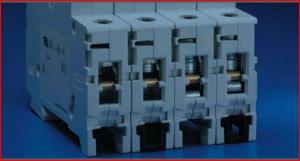 In order not to bring the matter to the point of disconnecting the entire object from the power supply due to an overload of a separate section, for example, a section of sockets, while turning on several sufficiently powerful electrical receivers at the same time, they use sectional circuit breakers.
In order not to bring the matter to the point of disconnecting the entire object from the power supply due to an overload of a separate section, for example, a section of sockets, while turning on several sufficiently powerful electrical receivers at the same time, they use sectional circuit breakers.
They are installed after PZR and protect the circuits of the section from short circuit currents and from overloads. Each sectional circuit breaker protects one particular section. The current settings of the thermal relays built into them are selected in such a way that when a section is overloaded, the sectional automat protecting it will turn off earlier, without leading to operation. PZR.
Protection sectional circuit breakers effective, but not very convenient.
Firstly, the load in several sections may not reach the maximum value at which the sectional machine would work, but in total it will be large enough to work PZR.
Second, to restore protective functions of a triggered machine, you must manually transfer it from a non-working to a working state - the lever from position "0" (or "off") to position "1" (or "on").
3. Apply priority relay
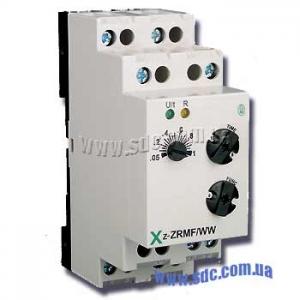 In the conditions when installed capacity home electrical receivers far outperforms permitted power and the probability of shutdown sectional circuit breakers
increases, use priority relay.
In the conditions when installed capacity home electrical receivers far outperforms permitted power and the probability of shutdown sectional circuit breakers
increases, use priority relay.
This is an electric current relay, to the input terminals of which the supply voltage is connected, and to the output terminals - separate sections of the internal electrical network, which have different priorities. For example, a socket section and an electric floor heating section. The socket section is given higher priority than the electric floor heating section.
Priority relay a mode is set in which the total load current in the connected sections reaches a certain value, it works and turns off one or more sections with a lower priority.
After some set time the relay loses power and sections with lower priority are automatically connected to the power supply. If the nature of the load has not changed, the relay operates again.
4. Use blocking relays
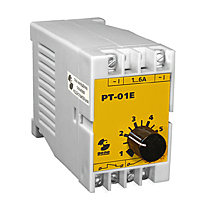
Latching relay(a current relay is used as a blocking relay) makes it impossible to simultaneously turn on two sections or separate electrical receivers of high power, depending on the connection point of the relay coil and its opening contact.
That section or that receiver (No. 1) is switched on, in the circuit of which the relay coil is installed, and that section or that receiver (No. 2), in the circuit of which its opening contact is located, is turned off.
If blocking relay has an adjustable setting, then the section or receiver No. 2 is switched off when the current in the section or receiver No. 1 reaches the specified value. Section or receiver No. 2 is connected to the voltage when the current in the section or receiver No. 1 drops to the setting value multiplied by the relay return factor, without time delay.
When using one relay, the effect is similar to that which occurs when using a priority relay: a higher priority will be given to the section or electrical receiver in whose circuit the relay coil is connected.
If you install blocking relays in both sections or in the power circuit of two receivers in a cross circuit, then the one (that) that was turned on first will remain working.
5. Apply power controls
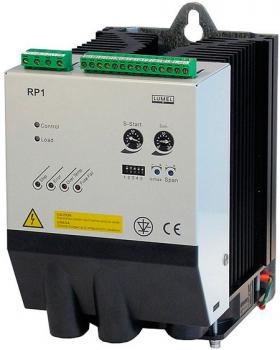 There are a number of electrical receivers, the power consumption of which can and should be regulated. These are sources of lighting (chandeliers, sconces, etc.), heating appliances(underfloor heating).
There are a number of electrical receivers, the power consumption of which can and should be regulated. These are sources of lighting (chandeliers, sconces, etc.), heating appliances(underfloor heating).
The power circuit of such receivers includes power regulators, containing thyristors.
By adjusting the moment of unlocking the thyristors, they change the magnitude of the current of electrical receivers, and, therefore, the power they consume.
As a rule, such regulation is carried out manually or using a remote control.
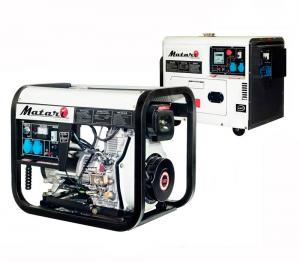 When by regulation it is impossible to achieve a condition that the maximum power consumption value did not exceed the value permitted power, use backup power.
When by regulation it is impossible to achieve a condition that the maximum power consumption value did not exceed the value permitted power, use backup power.
Backup power supply - it's usually diesel generator or gas generator(For economic reasons, they are usually used as an emergency source).
Turning on the generator and switching part of the sections or the entire internal network to standby power usually occurs automatically, but it is also possible manual mode. At the same time, it is important that, in order to avoid a short circuit, the internal network is first disconnected from the supply network, and only then connected to generator.
Backup power in the event of a power failure in the mains, it is used as an emergency.
It's very important to get it right choose a generator and know where install generator. And the quality of electricity and the reliability of the backup power supply system will depend on how it is done.
Conclusion
As you can see, all contain not prohibiting the use by the consumer of the totality of available electrical receivers, A make it impossible to use a certain part of them at the same time.
6 principles for organizing power supply in conditions of limited permitted power allow, with the rational use of available energy resources, to satisfy consumer demand over a longer time interval.
Light / Electrical connection
What is maximum power and how is it calculated? This question arises before anyone who begins to think about connecting their facility to the power grid. We publish the answer to this question from the specialists of the Interregional Distribution Grid Company (IDGC) of the Urals.
what is "maximum power"? How is it calculated?
"Maximum power" - the largest amount of power determined for simultaneous use by power receiving devices (power grid facilities) in accordance with the documents on technological connection and due to the composition of the power receiving equipment (power grid facilities) and the technological process of the consumer, within which the grid organization assumes obligations to ensure the transmission of electrical energy, calculated in megawatts (MW).
In the case of residential consumers (residential buildings individuals) the maximum power of electrical installations of each consumer is calculated as the algebraic sum of the rated powers according to the passports of all electrical receivers (electric water heaters, lighting, household appliances, etc.) multiplied by the electric power demand factor. In other words, this is the power that you will consume if you turn on everything that you want to include in the network. For individuals, it should not exceed 15 kW.
Usually it is less than the sum of the capacities of all electrical receivers in an apartment (house), because. rarely does anyone turn on the lights in the whole house at the same time, all the TVs, underfloor heating, stove, oven, kettle, microwave and vacuum at this time. The situation is quite real when having electrical appliances for 25-30 kW in the house, the consumer constantly consumes no more than 5-7 kW at the same time. According to the typical daily load schedules for electrical installations of household consumers, the maximum power is not a value that characterizes the average constant load of a household consumer. This is the value of the short-term maximum load that occurs during the hours of the morning and evening maxima. Most of the time, the consumer simultaneously requires power, which is several times lower than the maximum.
New Articles
- Russian-Portuguese phrasebook for tourists (travelers) with pronunciation
- Portuguese for tourists
- What are the main differences between Spanish in Spain and Latin America?
- Danish-Russian online translators Danish language translator
- What is the difference between Portuguese and Spanish
- Transiting Saturn Opposition Natal Saturn Moon-Saturn Opposition in Radix Male
- Horoscope of work and money
- Protection from the evil eye and envy will help save what is expensive. How to put protection from
- What does it mean if you have a dream within a dream?
- Chinese horoscope Ox (Ox)
Popular Articles
- Herbal teas for sore throat
- What to do with diarrhea and temperature in an adult
- Fortune telling on wax: the correct interpretation of the figures The procedure for conducting fortune telling
- Moon Pisces Compatibility Who suits a woman with the moon in Pisces
- What does a Scorpio love about sex?
- I dreamed of a neighbor descending from the stepladder along the vanga
- Short Course in Theoretical Mechanics
- Preparation for the exam in mathematics (profile level): tasks, solutions and explanations
- Sophia-Assumption Cathedral in Tobolsk
- The Poltava diocese confirmed its loyalty to the canonical Ukrainian Orthodox Church
